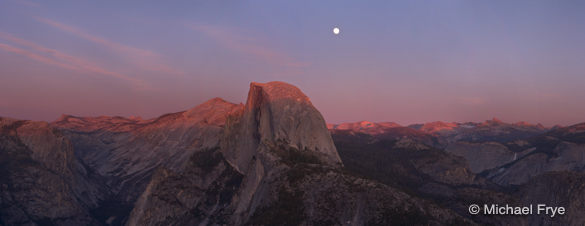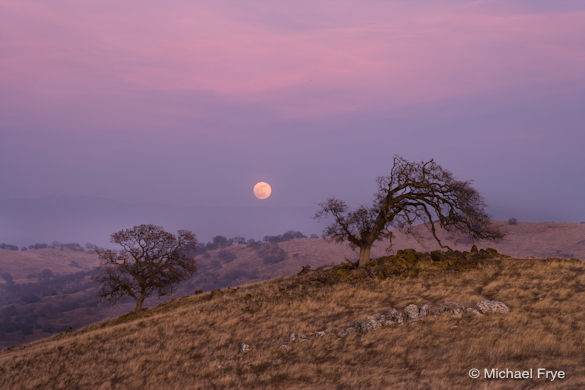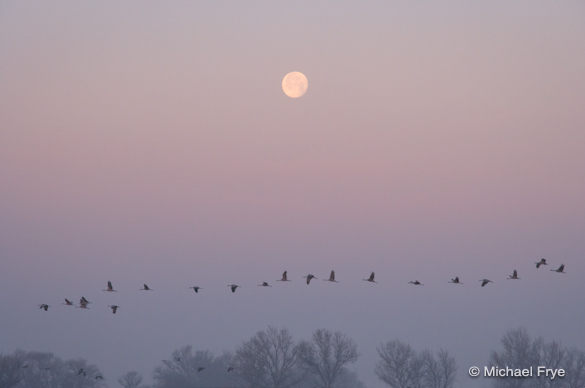In my post last Thursday I mentioned that there might be a good opportunity to photograph the moonrise from Glacier Point on Saturday evening. So Claudia and I went to Glacier Point that night, where we met lots of photographers. It was nice to see familiar faces, and meet some online acquaintances in person. Thanks to all of you who came up to me and said hello!
Of course in between socializing we all photographed the moon rising behind Half Dome. My favorite image from this evening is the panorama above (stitched together from five separate frames). If you were there, I’d love to see the images you made, so please post a link in the comments. And if you photographed the moon somewhere else, I’d like to see those images too!
On Sunday I knew the moon would be rising later, just as the sun was setting, so we looked for a spot with a low horizon to the east, and decided to head to the Mariposa County foothills. I’d been to this location before—in fact you may recognize one of these oak trees from my lunar eclipse image made in December. This time I looked east and photographed the moon rising over the hills and mountains.
Tuesday morning we rose early and headed down to Merced National Wildlife Refuge. We discovered thousands of sandhill cranes in a pond on the west side of the tour route, and photographed some of them juxtaposed with the setting moon as they flew out to feed.
I guess I can’t get enough of the moon! It always adds something to a photograph—perhaps a sense of mystery, or timelessness.
Photographs that capture the “moon above the landscape” are best taken near sunrise or sunset, a day or two before or after a full moon. When the moon is full it rises at sunset, so by the time it clears any mountains or hills to the east the landscape will be completely dark, making it impossible to expose both the moon and the landscape properly—unless, that is, you’re looking at a low, unobstructed horizon. At sunrise the moon will be setting just as the sun rises, and the moon may sink below the horizon before there’s enough light on the landscape.
But since the moon rises (and sets) approximately 50 minutes later each day, the day before it’s full the moon rises about 50 minutes before sunset, and two days before full it rises approximately 1 hour and 40 minutes before sunset. This gives the moon enough time to clear hills or even the rim of Yosemite valley before the the light fades, providing even illumination on both the moon and the landscape. And on the mornings following the full moon it will linger in the sky past sunrise, again allowing you to balance the light between the moon and your earthly surroundings.
New applications have made it easy to calculate the position of the moon, and predict exactly when it will clear the horizon from any given spot. I’ve mentioned the best of these programs here before, The Photographer’s Ephemeris. This piece of software has become an indispensable tool for me.
—Michael Frye
Related Posts: A Strange Winter Brings Unusual Opportunities; Eclipse
Michael Frye is a professional photographer specializing in landscapes and nature. He is the author and photographer of The Photographer’s Guide to Yosemite, Yosemite Meditations, and Digital Landscape Photography: In the Footsteps of Ansel Adams and the Great Masters, plus the eBook Light & Land: Landscapes in the Digital Darkroom. He has written numerous magazine articles on the art and technique of photography, and his images have been published in over thirty countries around the world. Michael has lived either in or near Yosemite National Park since 1983, currently residing just outside the park in Mariposa, California.












These are beautiful, Michael! I agree, the rising or setting moon really adds something different. Looks like you had some really nice skies to go with it. The moon looks especially large in your Sierra foothills shot. I know part of it is that the moon is so close to the horizon, and so looks bigger. Did you also use a telephoto lens on that one?
Thanks very much Vivienne. Yes, I used a telephoto for the foothills image – 118 mm.
The moonrise from Glacier Pt. is fantastic. The Sierra Foothills is also fantastic. Moonrise is always dependent on the sky, and you had some great ones. But it isn’t enough to have a great sky, you have to know what to do with it. You did great.
Thanks a lot Tom! I appreciate the kind words.
Michael, I particularly like the image of the Sandhill Cranes in flight below the moon – very artistic! As for pictures that I have of the full moon, here is a link: http://mountainmemories.zenfolio.com/p880431418/h25a715a4#h25a715a4
As the text below the picture explains I “cheated” in that I photoshopped a full moon that I had captured a few months earlier to a sunset picture of Garden of the Gods in November. Regardless, I liked the results. However, I don’t know that all will agree…
Thanks James. Glad you like the crane photo – I do too. And thanks for the link to your moon photo, and kudos for being honest about how it was made – not everyone does that. Everything in photography is subjective of course, and I tend to prefer more natural-looking images. But even without the moon the light is beautiful and the image is well composed.
Michael, I looked through some other photos that I had that contained moon images and found this one which I took of some fall aspen trees with a morning moon – not a moonrise. It’s not a great shot but at least it has the moon’s texture and is natural!
http://www.flickr.com/photos/aspenjim/6716202851
Thanks for sharing this image James. It’s a nice photo, though not in your top ten, I’m sure. Somehow images with the moon need to convey a bit of mystery I think.
Michael, is it snowing out there? I just saw the weather on the news
Send some of that snow to Colorado!
Not yet James. We’re supposed to get rain and higher elevation snow tomorrow and through the weekend. I’m sure some of it will head your way!
I was there Sunday, pretty tough as it got dark way before the moon came up. Also a bit hazy. Here are a few: https://picasaweb.google.com/107962409950996108064/Yosemite02
Doug
Doug, did you mean that you were at Glacier Point Sunday? Yeah, the eastern horizon is higher than you think there, so I’m sure it took awhile for the moon to rise. Sorry, your link didn’t work for me.
Michael, I could not make it Saturday so went up sunday. There were a few of us that night. Thanks for the head’s-up about the event, was really fun. Please try this link, kind of new at this sharing thing!!! I have the The Photographer’s Ephemeris, was a good tool. Someone else had sky view (??) on their iphone, which was pretty cool as it showed that actual location of the moon. Try this link for me: https://picasaweb.google.com/dhaines53/Yosemite02?authuser=0&feat=directlink
That link worked – nice!
>Someone else had sky view (??) on their iPhone
Sound like maybe Star Walk… ?
Hi Mike:
Beautiful work! I also planned to get the setting moon at dawn. I’ve been using an iPhone app to watch the tides, moon, and sunrise/sets.
We definitely have the tools out there to better our craft.
Below is a link to a shot I took out here on the east coast on Tuesday morning.
Have a great weekend!
Steve
https://www.facebook.com/photo.php?fbid=327174270639082&set=a.189651121058065.41481.189630887726755&type=1&theater
Nice image Steve, and thanks! The Photographer’s Ephemeris that I mentioned in the post is also available as an iPhone app.
Thanks Mike!
Michael,
Beautiful images, as always ! I particularly like the cranes one. I, too, find the Photographer’s Ephemeris a very valuable tool. Living in the Sedona, AZ area, I always refer to it prior to a full moon to try to determine which mountain formation I want to capture in the frame. It’s so easy to move the point of reference around and see exactly where the moonrise and sunset will occur. One of these days, I will have to venture out to Yosemite.
David
Thanks David. Sedona would be a great place for moonrise/set photos. Yosemite is pretty nice too. 🙂
Hi Michael
Here is a link to a picture I took at Glacier Point last Saturday.
It came out a bit dark on Facebook, and I have made adjustments since the, but here is the first cut image:
http://www.facebook.com/?ref=tn_tnmn#!/photo.php?fbid=293342754046989&set=a.193516550696277.45860.191103554270910&type=1&theater
Hopefully that link works
best regards
Chris
Yes, that link works, and the image turned out very well. It was nice to meet you at Glacier Point!
Michael,
As usual all tree pictures are very impressive, my favourite being Glacier Point,
you are very lucky to be so accessible to landscape as breath taking.
We have beautiful landscape in the UK, but not on such a large scale as this, “must visit”
best regards
Dave.
Thanks Dave, and hope you do get to visit Yosemite soon.
Nice shot Chris!
Hi Michael,
Wonderful images – as always! I especially love the moonrise photo.
Thank you for the tip about Saturday – it was a gorgeous sight indeed. I managed my little Buzz Lightyear & enjoyed the scenery while Venkatesh took the pictures. 🙂
It was a real pleasure meeting you in person.
– Maya
Thanks Maya! It was a pleasure meeting you and “Buzz Lightyear,” and seeing Venkatesh again.
Hi Michael,
I LOVE all of your moon shots. The one from Glacier Point is spectacular and the Sandhill Cranes is fantastic. I envy you being so close to fterrific scenery and having the knowledge of just how to capture it. I have soooo much to learn! Keep your camera busy. I look forward to more of your work.
Smiles,
Carol
Thanks very much Carol! Glad you like these images. I am lucky to live where I do.
Nice work, Michael! I particularly love the panorama.
Thanks Ian!
I’ll cast another vote for the cranes – nice pastel colors with the moon and birds. The others are nice too, but not as special to me. I’d wanted to drive out Saturday to Glacier Point, but just couldn’t get myself to make the trip. This is from Alamo Square in San Francisco, which was a much shorter trip for me. Unfortunately, by the time that bright spot on the buildings was gone, a group of people started playing around by the fountain in the foreground (much to the dismay of the dozen tripod-wielding photographers trying to catch the scene.
http://www.flickr.com/photos/imageskylejones/6698292995/
Thanks Kyle. Glad you like the crane photo – I do too. Sorry things didn’t work out in SF.
Michael,
I learned from this visit to CA to either bring my long lens and tripod (everything is fenced off, it seems) or just not bring my camera at all. Even with IS, the images are, uh, “soft”. In case the link doesn’t work, it’s my Picasa album called ‘moon shots for michael’.
That’s a beautiful pano you got. Hope to make it back to the Valley or East side this year.
Well I guess I’m attached to my tripod at the hip, so rarely encounter that problem. 🙂 Love the trees at Point Lobos.
Michael,
Nice feeling to the crane shot. A little eerie? The “wildlife as part of landscape” idea is one I really like (Michio Hoshino?), and one I think I’m seeing more of.
-eric
Thanks Eric. I’ve always like “animal in the landscape” photos more than closeup portraits.
Beautiful and inspiring shot of the cranes and moon. Have to plan a trip to the Merced reserve. Never been there. These reserves are real blessings. Someone mentioned the disappointment with all the fences along the Sierra foothills and it really a major bummer. There are still some areas without fences but they seem to be getting fewer and further between. Got to get out there, photograph and paint it before everything is closed off.
Terry
Thanks very much Terry – glad you like the crane photo. It is indeed wonderful that we have places like the Merced refuge.
Bonjour !
Conformément à votre demande, veuillez trouver ci-dessous quelques photos de paysages de Corse sans aucune prétention, caractérisées par la présence de la Lune.
En vous remerciant pour votre passage !
Cordialement,
Jean-Christophe
http://www.flickr.com/photos/55934959@N03/6498783545/in/photostream
http://www.flickr.com/photos/55934959@N03/6713555671/in/photostream
http://www.flickr.com/photos/55934959@N03/6498784157/in/photostream
http://www.flickr.com/photos/55934959@N03/6616043669/in/photostream
http://www.flickr.com/photos/55934959@N03/6616042571/in/photostream
http://www.flickr.com/photos/55934959@N03/6713549661/in/photostream
http://www.flickr.com/photos/55934959@N03/6713549203/in/photostream
http://www.flickr.com/photos/55934959@N03/6713548755/in/photostream
http://www.flickr.com/photos/55934959@N03/6724970205/in/photostream
http://www.flickr.com/photos/55934959@N03/6713555275/in/photostream